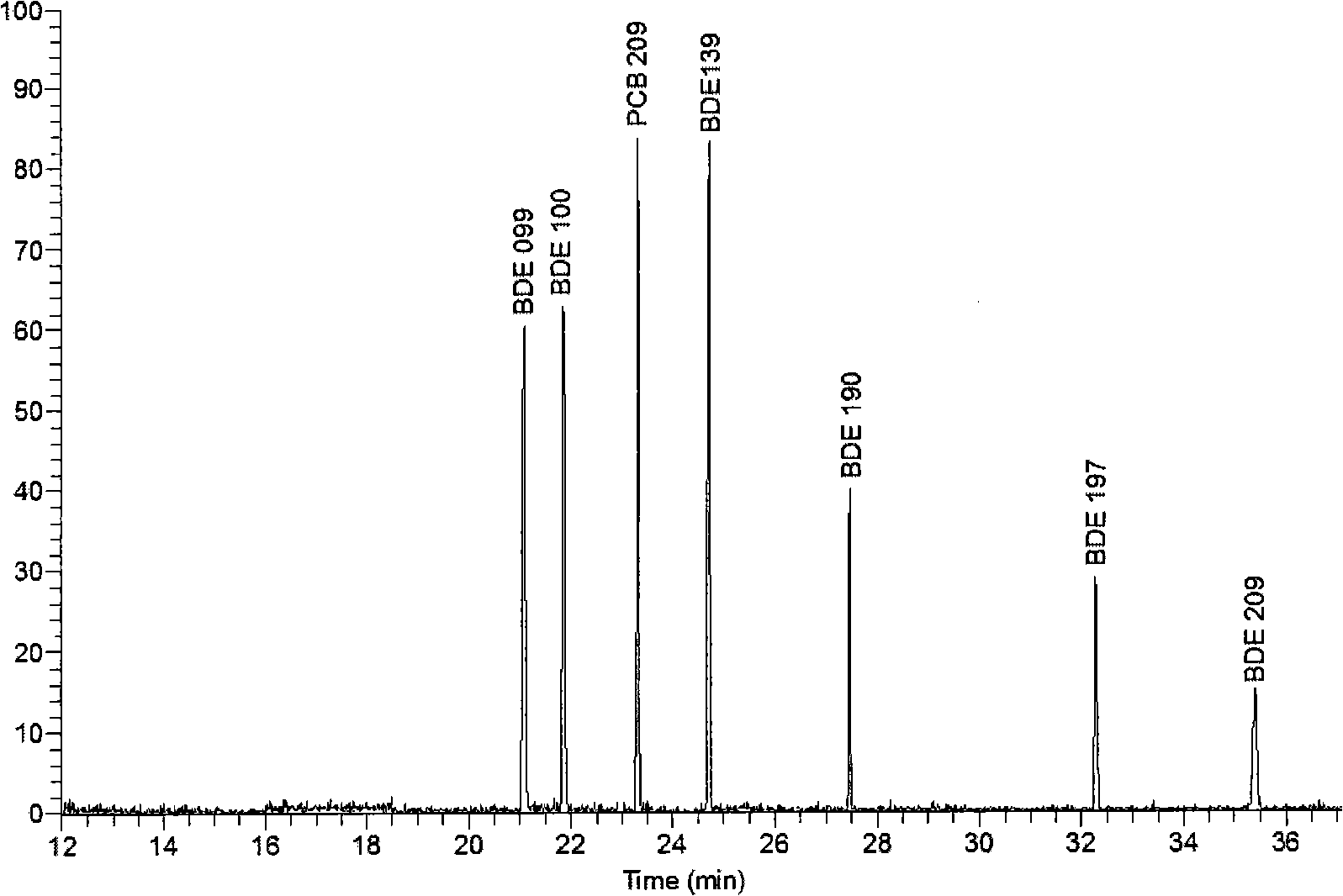Method for rapidly detecting polybrominated diphenyl ether residue in sample
A polybrominated diphenyl ether and detection method technology, which is applied in the field of rapid sample processing of polybrominated diphenyl ether residues, can solve the problems of large solvent consumption, high cost, time-consuming detection, etc., and achieve the effect of less analysis sample, fast extraction speed, fast automation
- Summary
- Abstract
- Description
- Claims
- Application Information
AI Technical Summary
Problems solved by technology
Method used
Image
Examples
Embodiment 1
[0036] The content detection of polybrominated diphenyl ethers in the standard lining product of embodiment 1
[0037] Materials and methods
[0038] Instruments and reagents:
[0039] HP6890GC gas chromatograph with 5975MSD, Anggilent TM (CA, US); HP-5 (15m×0.25mm×0.25μm, Fused silica capillary column), Angilent TM (CA, US); solid phase microextraction device (with 15mL operating platform): Supelo TM (PA, USA), dedicated for GC; SPME extraction fiber: 7 μm polydimethylsiloxane (PDMS), Supelo TM (PA, USA); Branson200ULTRASONIC Cleaner ultrasonic machine, Branson TM (MI, USA); chromatography vial: 22ML, La-pha-pack TM (Frankfurt, GM). Standard lining: multi-fiber standard lining MFF#10A (ISO105 / F10-1989), Textile Industry Standardization Institute.
[0040] Acetone (Acetone): HPLC grade, purchased from Ficher TM (MA, USA); Cyclohexane (Cyclohexane): HPLC grade, MERCK TM (NJ, USA); pure water (Water): HPLC grade, MERCK TM (NJ, USA); Sodium chloride (NaCl): AR.; Standar...
Embodiment 2
[0069] The optimization of solid-phase microextraction condition in the content detection method of polybrominated diphenyl ether in the standard lining product of embodiment 2
[0070] The aqueous solution containing part of the target compound at 10 μg / L is used as the sample matrix, that is, different comparisons are taken, and the ideal gas-liquid equilibrium conditions are selected according to the signal response (chromatographic peak area) of the target compound in GC / MS. The results show that the detection result is the most ideal when the ratio is 1:2 (v / v). Therefore, the bottom liquid volume of the extraction system was determined to be 10 mL.
[0071] In view of the factors that may affect the efficiency of solid-phase microextraction, under the determined bottom liquid conditions, the research uses a micro-injector to take a 100ng / mL standard solution in a 50mL volumetric flask, evaporate the solvent and dilute it with water to conduct solid-phase microextraction....
Embodiment 3
[0073] Example 3 The precision and recovery investigation test of the content detection method of polybrominated diphenyl ethers in standard lining products
[0074] Select the standard lining, and prepare a small standard sample with a standard solution of the target compound at a concentration of 10 ng / ml. Each sample was measured 10 times in parallel, and a blank test was performed on samples of the same material. The average value of the three blank measurement results was taken as the background, and the standard addition recovery was calculated after deducting the blank value. The measurement results are shown in Table 2. The recoveries of the blank spiked compounds were 81.9-103.1%, the RSDs were 2.2-8.9%, and the recoveries of the matrix spiked compounds were 71.9-107.1%, the RSDs were 5.8-10.1%.
[0075] Table 2 Blank standard addition and matrix (fabric) standard addition recovery measurement result
[0076]
[0077] Among them, BDE-099: 2,2', 4,4', 5-pentabromod...
PUM
 Login to View More
Login to View More Abstract
Description
Claims
Application Information
 Login to View More
Login to View More - R&D
- Intellectual Property
- Life Sciences
- Materials
- Tech Scout
- Unparalleled Data Quality
- Higher Quality Content
- 60% Fewer Hallucinations
Browse by: Latest US Patents, China's latest patents, Technical Efficacy Thesaurus, Application Domain, Technology Topic, Popular Technical Reports.
© 2025 PatSnap. All rights reserved.Legal|Privacy policy|Modern Slavery Act Transparency Statement|Sitemap|About US| Contact US: help@patsnap.com



